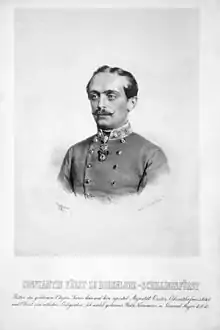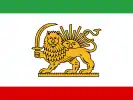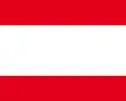Konstantin of Hohenlohe-Schillingsfürst
Konstantin Viktor Ernst Emil Karl Alexander Friedrich Prinz zu Hohenlohe-Schillingsfürst (born September 8, 1828, Schloss Schillingsfürst near Rothenburg ob der Tauber, Bavaria; died February 14, 1896, Vienna)[1] was a k.u.k. First Obersthofmeister (Lord High Steward or the chief of staff of the imperial and royal court) and General of the Cavalry of Austria-Hungary.

Biography
Family
Prince Konstantin of Hohenlohe-Schillingsfürst was the youngest son of Fürst Franz Joseph, 5th Prince of Hohenlohe-Schillingsfürst and his wife, Caroline Friederike Constanze of Hohenlohe-Langenburg. He had three older brothers who achieved high positions: Victor Herzog von Ratibor, President of the Prussian House of Lords, Chlodwig zu Hohenlohe-Schillingsfürst, Chancellor of Germany, and Gustav Adolf, Cardinal Prince of Hohenlohe-Schillingsfürst. In addition, he had three sisters and two other brothers died at a young age.
In 1859 Konstantin married Princess Marie zu Sayn-Wittgenstein (1837–1920) at Weimar. She was the daughter of Fürstin Carolyne zu Sayn-Wittgenstein (1819–1887) who after her divorce lived with Franz Liszt since 1848 at Weimar. In 1861 he bought Palais Dobner-Dobenau in Vienna, and the couple moved in the following year. His wife became a sponsor of Vienna's cultural life and a supporter of its social institutions. The couple had six children:
- Prince Franz Joseph zu Hohenlohe-Schillingsfürst (1861–1871)
- Prince Konrad of Hohenlohe-Schillingsfürst (1863–1918), Prime Minister of Austria-Hungary
- Prince Philipp zu Hohenlohe-Schillingsfürst (1864–1942), Pater Konstantin OSB
- Prince Gottfried zu Hohenlohe-Schillingsfürst (1867–1932), married Erzherzogin Maria Henriette von Österreich-Teschen (1883–1956)
- Prince Wolfgang zu Hohenlohe-Schillingsfürst (1869–1883)
- Princess Dorothea zu Hohenlohe-Schillingsfürst (1872–1954)
Career
Hohenlohe went to school at the Maria-Magdalenen-Gymnasium, Breslau graduating with the Abitur in 1848. The same year he joined the military of the Austrian Empire and served in a campaign in Northern Italy in 1849. In 1854 he entered service at the Royal Court in Vienna. He advanced becoming Aide-de-camp of Emperor Franz Joseph I. in 1859 and First "Obersthofmeister" with the elevated appointment to "Fürst" in 1866.[2] He was seen as the perfect courtier, always in agreement with the political views of the Emperor. As the highest court official, Hohenlohe had many administrative and representative duties and was at the center of the political and cultural life at the Austrian Court. After the Ausgleich of 1857, the term k.u.k. was added to his title signifying that his duties were to both parts of Austria-Hungary.[1]
In 1857, Emperor Franz Joseph I of Austria issued the decree "I have resolved to command" (Es ist Mein Wille at Wikisource) ordering the demolition of the city walls and moats. In his decree, he laid out the exact size of the Ringstrasse, the new representative boulevard, as well as the geographical positions and functions of the new buildings. Hohenlohe was responsible for buildings and properties of the Royal Court along the Ringstrasse as well as the completion of the Hofoperntheater, and the new construction of the Hofburgtheater und of two new museums, the Kunsthistorisches Museum and the Naturhistorisches Museum. The construction of the Neue Burg at the Hofburg was not completed until the First World War. Hohenlohe participated in the development of the Wiener Prater where the World Exhibition took place in 1873. The Konstantinhügel in the Prater is named after him. Hohenlohe also oversaw work for the Vienna Danube regulation.[3]
Hohenlohe worked until his death in 1896 and was succeeded by Rudolf von Liechtenstein.
Honors and dedications
- Orders and decorations[4]
- House of Hohenlohe: Knight of the House Order of the Phoenix, 1st Class
.svg.png.webp) Austria-Hungary:
Austria-Hungary:
.svg.png.webp) Grand Duchy of Tuscany: Grand Cross of St. Joseph
Grand Duchy of Tuscany: Grand Cross of St. Joseph Russian Empire:
Russian Empire:
- Knight of St. Andrew, in Diamonds
- Knight of St. Alexander Nevsky
- Knight of the White Eagle
- Knight of St. Anna, 1st Class
- Knight of St. Stanislaus, 1st Class
- Knight of St. Vladimir, 4th Class
.svg.png.webp) Kingdom of Prussia:
Kingdom of Prussia:
- Knight of the Black Eagle, in Diamonds
- Knight of the Red Eagle, 1st Class
- Knight of the Prussian Crown, 2nd Class
.svg.png.webp) France: Grand Cross of the Legion of Honour
France: Grand Cross of the Legion of Honour.svg.png.webp) Empire of Brazil: Grand Cross of the Southern Cross
Empire of Brazil: Grand Cross of the Southern Cross.svg.png.webp) Ottoman Empire:
Ottoman Empire:
- Order of Osmanieh, 1st Class
- Order of the Medjidie, 1st Class
_crowned.svg.png.webp) Kingdom of Italy: Knight of the Annunciation, 6 February 1874[7]
Kingdom of Italy: Knight of the Annunciation, 6 February 1874[7]
.svg.png.webp) Two Sicilian Royal Family:
Two Sicilian Royal Family:
- Knight of St. Januarius
- Commander of the Order of Francis I
.svg.png.webp) Sovereign Military Order of Malta: Bailiff Grand Cross of Honour and Devotion
Sovereign Military Order of Malta: Bailiff Grand Cross of Honour and Devotion.svg.png.webp) Holy See:
Holy See:
- Grand Cross of the Order of Pope Pius IX
- Knight of the Supreme Order of Christ
 Persian Empire:
Persian Empire:
- Order of the August Portrait, in Diamonds
- Order of the Lion and the Sun, 1st Class
.svg.png.webp) Empire of Japan: Grand Cordon of the Rising Sun
Empire of Japan: Grand Cordon of the Rising Sun Denmark: Knight of the Elephant, 16 November 1879[8]
Denmark: Knight of the Elephant, 16 November 1879[8].svg.png.webp) Kingdom of Portugal: Grand Cross of the Tower and Sword
Kingdom of Portugal: Grand Cross of the Tower and Sword.svg.png.webp) Spain: Grand Cross of the Order of Charles III, 5 September 1868; with Collar, 27 November 1879[9]
Spain: Grand Cross of the Order of Charles III, 5 September 1868; with Collar, 27 November 1879[9].svg.png.webp) Kingdom of Bavaria:
Kingdom of Bavaria:
- Knight of St. Hubert, 1868[10]
- Knight of Merit of the Bavarian Crown
.svg.png.webp) Kingdom of Saxony:
Kingdom of Saxony:
 Württemberg:[11]
Württemberg:[11]
.svg.png.webp)
 Sweden-Norway: Knight of the Seraphim
Sweden-Norway: Knight of the Seraphim.svg.png.webp) Belgium: Grand Cordon of the Order of Leopold (civil), in Diamonds, 16 July 1867[12]
Belgium: Grand Cordon of the Order of Leopold (civil), in Diamonds, 16 July 1867[12].svg.png.webp) Kingdom of Greece: Grand Cross of the Redeemer
Kingdom of Greece: Grand Cross of the Redeemer Kingdom of Romania: Grand Cross of the Star of Romania
Kingdom of Romania: Grand Cross of the Star of Romania.svg.png.webp) Principality of Serbia:
Principality of Serbia:
 Electorate of Hesse: Grand Cross of the Wilhelm Order
Electorate of Hesse: Grand Cross of the Wilhelm Order Grand Duchy of Hesse: Grand Cross of the Ludwig Order, 1 November 1873[13]
Grand Duchy of Hesse: Grand Cross of the Ludwig Order, 1 November 1873[13].svg.png.webp) Saxe-Weimar-Eisenach: Grand Cross of the White Falcon, 1885[14]
Saxe-Weimar-Eisenach: Grand Cross of the White Falcon, 1885[14] Mecklenburg: Grand Cross of the Wendish Crown
Mecklenburg: Grand Cross of the Wendish Crown.svg.png.webp)
.svg.png.webp)
.svg.png.webp) Ernestine duchies: Grand Cross of the Saxe-Ernestine House Order, 1870[15]
Ernestine duchies: Grand Cross of the Saxe-Ernestine House Order, 1870[15].svg.png.webp) Nassau Ducal Family: Knight of the Gold Lion of Nassau
Nassau Ducal Family: Knight of the Gold Lion of Nassau.svg.png.webp) Principality of Montenegro: Grand Cross of the Order of Prince Danilo I
Principality of Montenegro: Grand Cross of the Order of Prince Danilo I
- Civil appointments
- Honorary member of the Gesellschaft der Musikfreunde, 1870
- Honoray Kurator of the Academy of Fine Arts Vienna, 1873
- Honorary Kurator of the Museum of Applied Arts, Vienna, 1873
- Member of the Herrenhaus of Austria
Johann Strauss Jr. dedicated his waltz Geschichten aus dem Wienerwald to Hohenlohe in 1868 and Anton Bruckner dedicated his Symphony No. 4 in E-flat major to him in 1873.
Literatur
- "Hohenlohe-Schillingsfürst Konstantin Prinz zu". In: Österreichisches Biographisches Lexikon 1815–1950 (ÖBL). Vol. 2, Austrian Academy of Sciences, Vienna 1959, p. 393 f. (Direct links to "p. 393", "p. 394")
- Martina Winkelhofer-Thyri: Prinz Constantin zu Hohenlohe-Schillingsfürst (1828–1896). Der große Unbekannte am Wiener Hof. In: Alma Hannig, Martina Winkelhofer-Thyri (Hrsg.): Die Familie Hohenlohe. Eine europäische Dynastie im 19. und 20. Jahrhundert. Verlag Böhlau, Köln 2013, ISBN 978-3-41222201-7, S. 181–198.
References
- Austria Forum: Entry for Konstatin zu HS
- See Hof- und Staatshandbuch des Kaiserthumes Österreich, Wien 1868, S. 9.
- Obituary, Wiener Salon, February 15, 1896
- "Hofstaat Seiner Kaiserlichen und Koniglich Apostolischen Majestat", Hof- und Staatshandbuch der Österreichisch-Ungarischen Monarchie, 1896, p. 15, retrieved 25 August 2020
- Boettger, T. F. "Chevaliers de la Toisón d'Or - Knights of the Golden Fleece". La Confrérie Amicale. Archived from the original on 2018-07-29. Retrieved 25 June 2019.
- "A Szent István Rend tagjai" Archived 22 December 2010 at the Wayback Machine
- Italia : Ministero dell'interno (1884). Calendario generale del Regno d'Italia. Unione tipografico-editrice. p. 48.
- Jørgen Pedersen (2009). Riddere af Elefantordenen, 1559–2009 (in Danish). Syddansk Universitetsforlag. p. 472. ISBN 978-87-7674-434-2.
- "Real y distinguida orden de Carlos III". Guía Oficial de España (in Spanish). 1887. pp. 149, 152. Retrieved 25 August 2020.
- Hof- und Staatshandbuch des Königreichs Bayern: 1877. Landesamt. 1877. p. 10.
- Hof- und Staats-Handbuch des Königreich Württemberg (1886/7), "Königliche Orden" pp. 37, 79
- Almanach royal officiel de Belgique. Librairie polytechnique De Decq. 1868. p. 53.
- Hof- und Staats-Handbuch ... Hessen (1879), "Großherzogliche Orden und Ehrenzeichen" p. 24
- Staatshandbuch für das Großherzogtum Sachsen / Sachsen-Weimar-Eisenach (1891), "Großherzogliche Hausorden" p. 33
- Staatshandbücher für das Herzogtum Sachsen-Coburg und Gotha (1884), "Herzogliche Sachsen-Ernestinischer Hausorden" p. 31